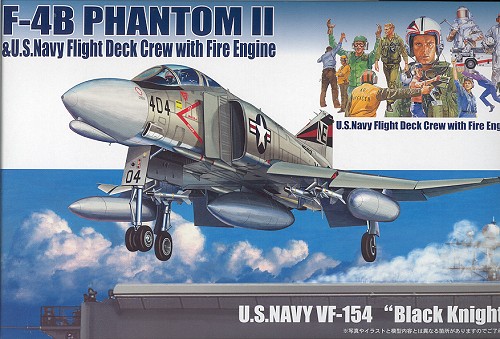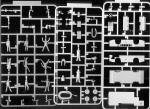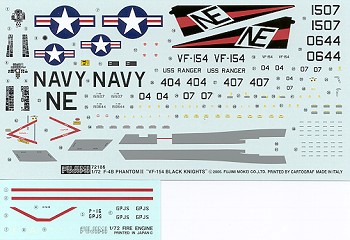
| KIT: | Fujimi 1/72 F-4B Phantom II "VF-154 Black Knights" |
| KIT #: | 72186 |
| PRICE: | ¥2500 at Hobby Link Japan |
| DECALS: | Two options |
| REVIEWER: | Scott Van Aken |
| NOTES: | Includes deck crew and fire truck |

| HISTORY |
It would be redundant to go over the history of the F-4 Phantom II, but redundant is what we are all about so here it is again. 1955: the Navy wanted a fleet interceptor to replace the F-8. McDonell provided an upgraded and twin engine F3H Demon that was so different that it was redesignated the F4H Phantom II. Navy liked it. First flew in 1958 with deliveries to fleet squadrons a few years later. So much better than anything else around that the USAF ordered a bunch of them (the first Navy aircraft ever bought by the USAF) and eventually operated more F-4s than the USN. The F-4As were all used for systems development and training with the first deployed F-4s being the F-4B with VF-74 in 1961. Eventually the type saw combat in Vietnam before the F-4J arrived in the late 1960s. Extant F4Bs were converted to F-4N variants and were withdrawn from service in the late 1980s. Many of these were converted to QF-4N drones and served until the early 2000s when replaced by QF-4S. All QF-4s are now out of service with the closing of the USN full scale target program in 2004/5.
| THE KIT |
 Fujimi
was probably the company that started all the 'one basic set of molds to do
multiple variants' thing and their F-4 series was, for a number of years,
the best 1/72 F-4 that you could buy. Your editor built a bunch of these
kits and has a number still in the stash. They are quite good, though not
quite as detailed as the Hasegawa kits.
Fujimi
was probably the company that started all the 'one basic set of molds to do
multiple variants' thing and their F-4 series was, for a number of years,
the best 1/72 F-4 that you could buy. Your editor built a bunch of these
kits and has a number still in the stash. They are quite good, though not
quite as detailed as the Hasegawa kits.
While they have a full cockpit, the detail level isn't quite as high as one would want with the instrument panels and side consoles being decals. The basic tub is that for a USAF aircraft which has a different back seat area than USN/USMC F-4s. The seats are also a tad on the generic side. If you have a Monogram F-4J that has suffered an alpha strike, then you may want to use that tub as the later kits had a proper USN back seat. I should mention that the image of the sprues has been swiped from a previous F-4N preview and does not show the separate canopy sections or the additional bulkheads for the cockpit that were part of Fujimi's kit upgrade after the 12th boxing. Other than that, the plastic is the same.
Fujimi supplies stabilizers that are more appropriate for USAF Phantoms. While they are the correct unslotted stabs used by F-4B/C/D, they have the reinforcement tab that I don't believe was used by USN Phantoms. Later Bs and some more of the Ns were retrofitted with the slotted stab as used on the J and later E versions. Means you'll probably have to sand off the reinforcement and rescribe. No big deal as I've done it lots of times in the past.
Molding has held up fairly well over the years. I did notice a LOT of sink areas on the wing upper surface and on the main gear doors. Apparently, this sprue was run too fast through the molds or this wouldn't have happened. Filler is the only cure. These are the correct thin wings for the B/N variant. While on that subject, there are the proper intake ECM fairings in case you wanted to do an N. VF-154 did operate the N for three cruises on the USS Coral Sea, trading in their Js for the privilege along with their sister squadron, VF-21. Things under wings are two drop tanks and a larger centerline tank. A proper USN Sidewinder pylon is provided along with four early Sidewinders and four Sparrows. Other than ferry flights, rarely were all three tanks carried. Generally just the wing ones or just the centerline.
 Moving
on to the deck crew and fire truck. This is a very nice addition, and adds
value to the kit. The situation is that VF-154 got rid of their F-4Bs in
1970, trading them in on F-4Js. The figures and fire truck are more
appropriate for modern USN; at least from the early 1990s after the Phantom
was out of fleet service. Several give-aways regarding this. One is the use
of cranials, something we didn't have back in the late 1960s. Another is
the low slung fire truck. Back then we didn't have these and they would
have been red. You could make it a standard tow tractor, though it is a bit
too modern. Then you'd have to paint it yellow, not the white that is used
today. The switch from yellow to white G
Moving
on to the deck crew and fire truck. This is a very nice addition, and adds
value to the kit. The situation is that VF-154 got rid of their F-4Bs in
1970, trading them in on F-4Js. The figures and fire truck are more
appropriate for modern USN; at least from the early 1990s after the Phantom
was out of fleet service. Several give-aways regarding this. One is the use
of cranials, something we didn't have back in the late 1960s. Another is
the low slung fire truck. Back then we didn't have these and they would
have been red. You could make it a standard tow tractor, though it is a bit
too modern. Then you'd have to paint it yellow, not the white that is used
today. The switch from yellow to white G SE
came in the late 80s. Third is that there is at least one female deck
crewman. No women on carriers in 1969/70. Despite this, it is a useful set
that can be used with later model USN stuff. You could also ignore the
differences or do some work to backdate the figures.
SE
came in the late 80s. Third is that there is at least one female deck
crewman. No women on carriers in 1969/70. Despite this, it is a useful set
that can be used with later model USN stuff. You could also ignore the
differences or do some work to backdate the figures.
Instructions are just fine, and while they are mostly in Japanese, they do provide enough English when it comes to colors and such to be helpful. Color references are to Gunze paints. Markings are for two different VF-154 aircraft. These differ only in serial numbers and modex. They are in the light gull grey over white scheme with white radomes. The decals seem to be quite well printed and though a tad thicker than aftermarket ones, should present no real problems. You'll find that both the wing walk and intake walk areas are provided on the sheet. This makes things a lot easier than trying to paint them on. Decals for the fire truck are also provided.
| CONCLUSIONS |
Overall, it is good to see that Fujimi is still a going concern. Despite the small glitches I mentioned, most of which can be fixed with no problems, this does build into a very nice model. It is less fussy than the Hasegawa kit because there are fewer inserts. Having the deck crew and fire engine is an added bonus. I'll have this one on the bench once some space is cleared away!
October 2005
 My thanks to Hobby Link Japan for the
review kit. Please visit them for this kit and a wide variety of items that
you can generally only get in Japan.
My thanks to Hobby Link Japan for the
review kit. Please visit them for this kit and a wide variety of items that
you can generally only get in Japan.
If you would like your product reviewed fairly and fairly quickly by a site that has nearly 300,000 visitors a month, please contact me or see other details in the Note to Contributors.